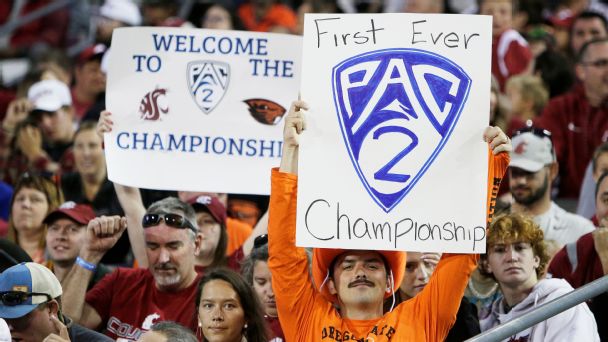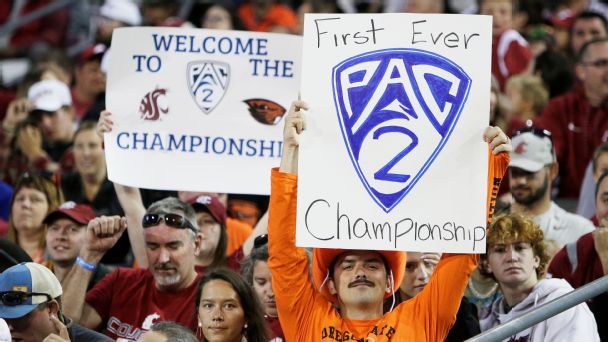
It happens early in the life cycle of any American sports fan getting into European soccer for the first time: the “Oh wow, relegation is amazing” realization, followed pretty quickly by the “We should have this in [insert favorite sport]!!” declaration. Promotion and relegation is an incredible concept, a way of inserting meritocracy into a widespread and popular sport, and it is absolutely foreign to American sports. Even Major League Soccer has resisted it, and it’s a soccer league! With 29 teams!
Still, the concept is ripe for what-if exercises, especially within college sports, where conference membership is often based less on merit and more on which neighbors you were playing against 90 years ago.
I do not say this as a brag — the opposite, perhaps — but I’m confident in saying that I have thought more and written more words about relegation in college football than anyone on the planet. (So, so many words.) As a frequent writer in both the college football and European soccer realms, I feel the two sports are ridiculously similar. Both are territorial sports, and in both, the historical rabbit holes are almost as endless as the financial inequalities and endlessly disappointing leadership.
Unlike soccer, though, college football remains relegation free. For now. At least one conference is considering changing that. Oregon State and Washington State — as it stands, the only two teams that will be remaining in the Pac-12 next summer when a round of conference realignment decimates the conference — have been in discussions with the Mountain West about creating a football alliance of schools that could feature multiple tiers of teams that are promoted and relegated between tiers based on conference finish.
I have waited a long time for this moment. If you’ve wasted countless hours of your life thinking about something, the least you can do is share some of those thoughts when they become even slightly relevant. So let’s talk about how relegation could work in college football.

First things first: How does this work in soccer?
Let’s start with the basics, just in case you aren’t one of those burgeoning soccer converts mentioned above. Throughout most continents — not just Europe — soccer tiers are established via promotion and relegation. But Europe provides clear examples of how things can work.
In England, there are four tiers of professional football, starting with the Premier League (which has 20 teams) and going down to the second-tier Championship (24), third-tier League One (24) and fourth-tier League Two (24). At the end of a round-robin season, the bottom three teams from the Premier League are relegated to the Championship, while three teams move up to enjoy the Premier League’s riches: the top two finishers in the Championship, plus the winner of a two-round playoff between the teams ranked third through sixth. It’s the same for each division moving down. The finals of each promotion playoff are played at the cavernous Wembley Stadium. It’s a pretty big deal.
In Italy, the Serie A promotion playoff from the second division is even bigger — it includes six teams and three rounds over 2½ weeks. (It’s a bit much, if we’re being honest.) In Germany, the bottom two teams in the Bundesliga are auto-relegated, but the third-lowest team gets a chance to avoid relegation by playing in a playoff against the third-highest team in the second division.
There are many variations of this — and in some countries, leagues will look at performance over a multiyear basis to determine who should move up or down — but the concept remains the same: Bad teams go down, and better teams go up.
What’s the draw of relegation?
The existential tension emanating from a relegation scrap can be almost as gripping and must-watch as a good title race. There is nothing comparable in American sports. Behold, these scenes from when Leeds United clinched 17th place with a win at 13th-place Brentford on the final day of 2021-22.
🤯 “Absolute pandemonium!” pic.twitter.com/19shRKXv1d
— Leeds United (@LUFC) May 22, 2022
🇧🇷 Football is art! pic.twitter.com/FAHaOsVeqG
— Leeds United (@LUFC) May 22, 2022
(Leeds got relegated the next season. But still!)
Imagine something like a 3-8 team playing at a 5-6 team on the final day of a college football season. Barring a Hail Mary or something, this would be completely unmemorable for all but the most hardcore of fans. Now imagine if the 3-8 team was an SEC team trying to avoid getting relegated to the Sun Belt. This tension is certainly unbearable for fans of the teams involved, but it adds an extra layer of importance and watchability to the home stretch of a given season.
That sounds fun, but college football is already pretty exciting and watchable. What else might this offer?
It also adds a word we rarely associate with college football: merit.
Vanderbilt and Mississippi State are not in the Southeastern Conference because they have two of the 14 (soon to be 16) best athletic departments or football programs in the Southeast. They’re there because they’ve always been there. Colorado was good for basically 1.5 of the past 17 seasons before 2023 but got to play a major role in two power conference realignment sagas. Kansas has been decent once in 14 years but continues to play Big 12 football. Meanwhile, Boise State played the part of a major college football program for years — nearly elite for a few, too — and never got a major conference sniff because it’s in Idaho. North Dakota State and South Dakota State have done more to earn Big Ten membership in the past 15 years than Indiana or Rutgers.
To play in the top level of soccer in a given country, you have to earn your spot and re-earn it every season. Novel, huh?
With promotion and relegation, cream rises. And it makes conferences better. Take, for instance, the Big 12 and AAC. Let’s pretend for a moment that those leagues had a “top two AAC teams move up, bottom two Big 12 teams move down” arrangement. At the end of this season, Houston (No. 70 in SP+) and Baylor (No. 66) might be replaced by Tulane (No. 38) and Memphis (No. 41). As a result, the Big 12 improves. And while the AAC technically gets worse, it might also improve from adding the best teams from, say, the Missouri Valley (NDSU and SDSU). The circle of life.
Interesting. So what exactly is the MWC considering?
The details remain a bit blurry, but we can start piecing together the initial plan. Front Office Sports acquired a PowerPoint presentation shared with athletic directors both within and outside of the Mountain West that envisioned a group of up to 24 teams including not only Oregon State and Washington State and the current MWC members, but also region-appropriate teams from other conferences. They would create a football-only structure — the conferences could remain untouched for other sports — in which teams are promoted and relegated into at least two tiers.
According to Yahoo! Sports, which spoke to people who saw the presentation, the two remaining Pac-12 schools could join with the MWC and two other programs to create two eight-team leagues. A top tier of OSU, WSU and the top six MWC programs, could perhaps, be paired with a bottom tier of the other six MWC teams and two expansion candidates (North Dakota State and South Dakota State? Semiregional FBS programs like UTSA and Texas State?).
You could craft a conference schedule around the seven other teams in your tier, with a spot or two remaining for opponents in the other tier. (That’s important for assuring that major rivalries remain continuous.) Championship Weekend could include not only a Pac-12 championship game but also a “relegation game” between the sixth- and seventh-place teams in the Pac-12 — with the last-place team automatically dropping — and a “promotion game” between the second- and third-place teams in the MWC after the champ earns an automatic bump.
Based on current SP+ rankings, you might start with a hypothetical top tier of these teams: No. 20 Oregon State, No. 38 Washington State, No. 57 Boise State, No. 59 Air Force, No. 61 Fresno State, No. 84 San Diego State, No. 88 San José State and No. 89 Wyoming.
The second tier could consist of South Dakota State (No. 43 in SP+ if they were in FBS) and North Dakota State (No. 53), plus UNLV, Utah State, Colorado State, Hawai’i, Nevada and New Mexico. If the three-tier, 24-team vision were to come to fruition, it could also include some combination of top-100 FBS teams on or west of the Mississippi River, such as Memphis, Tulane, UTSA and Texas State, plus perhaps top-100 caliber Big Sky programs like Montana, Montana State, Sacramento State, Weber State or Idaho. Within a couple of years, you could have a top tier of Oregon State, Washington State, Memphis, Tulane, Air Force, Boise State, Fresno State and someone like UTSA, San Diego State or one of the Dakotas. Is that a power conference? Not quite, but at worst it’s easily the best of the non-powers. It would produce a top-25 caliber champion more often than not.
OK, sounds great, but how would the money work?
That’s a very good question, one that’s impossible to answer just yet.
In theory, a Mountain West with more good programs and more high-interest matchups commands a better media rights deal than what it is currently working with, but the league would have to figure out what percentage to distribute to each tier. It would also have to decide on things like “parachute payments” — a Premier League system in which relegated teams receive a percentage of top-tier money (diminishing each year) to assure that the financial impact of falling off the ladder isn’t quite as much of a shock.
There’s also the issue of a school trying to draw up an athletic budget flexible enough to account for the sudden loss of a few million dollars it was planning on having. Obviously soccer clubs do this annually — sometimes they do this very poorly and end up with serious issues — and everyone would adapt, but there would be quite a bit of short-term awkwardness.
What are some drawbacks?
You mean beyond “They have 400 decisions to make and not exactly a ton of time to make them?”
Yes.
OK. Since we’re treating this idea as a realistic one for this moment, we should probably acknowledge that there are quite a few drawbacks of the more and less obvious varieties.
Schools take fewer risks when relegation is on the line. Remember when Kentucky hired Valdosta State’s Hal Mumme in the 1990s, setting into motion a chain of events that led to Mike Leach’s emergence as a major college football coach and college football’s evolution into something far more interesting and pass-happy? UK almost certainly doesn’t consider making such an outside-the-box decision if the punishment for it going wrong is relegation to the Sun Belt.
Granted, the Wildcats had enjoyed one winning season in 12 years before hiring Mumme. They’d have already been in the Sun Belt. And those hires are rare anyway. But in soccer, tactical innovation often comes from the top of the sport and trickles down. It sometimes happens that way in college football — the Wishbone revolutionized the sport in the late 1960s and originated at Texas — but some of the sport’s biggest innovations have trickled upward, and that would be more difficult to pull off.
There’s also the whole matter of panic firings: College football programs already make increasingly rash decisions of this nature, and that’s without the fear of relegation.
Promotion and relegation have in no way prevented top-down inequality in soccer. It’s great to actually introduce merit and reward the programs that have been most well-run for a long period of time. But in a relegation structure, a sport’s middleweight or light-heavyweight programs often bounce between levels while the heavyweights are rarely threatened with falling to a lower division. Over time, the less monied clubs end up making less than the clubs that already had more money. Granted, this isn’t as much of an issue with the current MWC example, but if this were to catch on throughout the sport, it wouldn’t do anything to address what is already far too much of a haves-over-have-nots situation.
Goodness, can you imagine the transfer portal in a universe with relegation?
Right? Admittedly, things can only get so much wilder than they already are, but “43 San José State players enter the transfer portal the day after a season-ending loss clinches relegation” is one way to do it.
Wouldn’t the NCAA also have to change some rules to allow something like this?
Yes. And needing the NCAA’s help to do anything (A) helpful and (B) in a timely manner is generally a fraught proposition.
This isn’t going to happen, then, is it?
It seems like the primary decision-makers involved are very much open to new ideas, and let’s be honest, it would be poetic if the first conference to move in this incredible direction was the MWC. The Mountain West is the spiritual home of the original WAC, the first conference to attempt mega-conference status when it expanded to 16 teams in 1996. It was a mess, and eight programs quickly broke off to form the original MWC — Air Force, BYU, Colorado State, New Mexico, SDSU, UNLV, Utah and Wyoming, six of whom remain in the conference. But if anyone has proved unafraid of thinking outside of the box and risking being ahead of its time, it’s this collection of schools. And implementing it on a smaller scale like this, instead of in some FBS-wide structure, is the only way it will ever happen.
That said … no, I’m not expecting this to actually happen. I’ll keep my fingers crossed, but I assume the complicated nature of the change — the weird budgeting, the required rule changes, etc. — prevent it from happening anytime soon, even with a less change-averse crowd. But I can dream.












